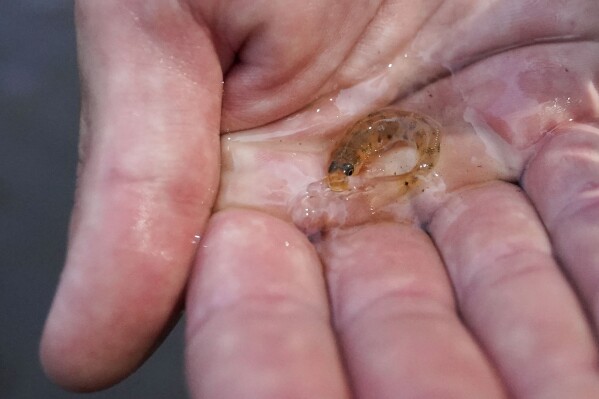More wild Atlantic salmon found in U.S. rivers than any time in the past decade, officials say
PORTLAND, Maine (AP) — The last wild Atlantic salmon that return to U.S. rivers have had their most productive year in more than a decade, raising hopes they may be weathering myriad ecological threats.
Officials counted more than 1,500 of the salmon in the Penobscot River, which is home to the country’s largest run of Atlantic salmon, Maine state data show. That is the most since 2011 when researchers counted about 2,900 of them.
The salmon were once abundant in American rivers, but factors such as overfishing, loss of habitat and pollution reduced their populations to only a handful of rivers in Maine. The fish are protected by the Endangered Species Act, and sometimes only a few hundred of them return from the ocean to the rivers in a year.
The greater survival of the salmon could be evidence that conservation measures to protect them are paying off, said Sean Ledwin, director of the Maine Department of Marine Resources sea-run fish programs. The count of river herring is also up, and that could be aiding the salmon on their perilous journey from the sea to the river.
 In Mississippi, a tiny fish is reintroduced to the river where it disappeared 50 years ago
In Mississippi, a tiny fish is reintroduced to the river where it disappeared 50 years ago
 Maine’s puffin colonies recovering in the face of climate change
Maine’s puffin colonies recovering in the face of climate change
 With drones and webcams, volunteer hunters join a new search for the mythical Loch Ness Monster
With drones and webcams, volunteer hunters join a new search for the mythical Loch Ness Monster
“The increasing runs of river herring help distract hungry predators such as seals and striped bass from the relatively rarer Atlantic salmon, which may help increase salmon survival of the predator gauntlet,” Ledwin said.
Americans eat a lot of farmed Atlantic salmon from expansive aquaculture operations. Commercial fisheries for wild Atlantic salmon in the U.S. closed decades ago due to overfishing and pollution. They once ranged south to Long Island Sound, off of Connecticut and New York.
But counts of wild salmon have been trending up in recent years. The count of salmon at the Milford Dam in the Penobscot River has been over 1,000 in four of the last five years, Maine data show. That followed several years in a row when the count never exceeded 840.
The Penobscot River once supported runs of salmon in the tens of thousands, in the era before intense damming of rivers, said Dan McCaw, fisheries program manager for the Penobscot Nation. The Native American tribe has lived along the river for thousands of years.
“So it is a tick up compared to previous years, but in the grand scheme of things, it’s still abysmal,” McCaw said.
Conservation groups in New England have long focused on removing dams and restoring salmon. They’re emboldened by the salmon’s gains this year, said Neville Crabbe, spokesperson for the Atlantic Salmon Federation.
“It’s going to take a commitment from everybody in the world to reduce emissions, and try to negate the most severe implications of climate change,” Crabbe said.
Disclaimer: The copyright of this article belongs to the original author. Reposting this article is solely for the purpose of information dissemination and does not constitute any investment advice. If there is any infringement, please contact us immediately. We will make corrections or deletions as necessary. Thank you.




